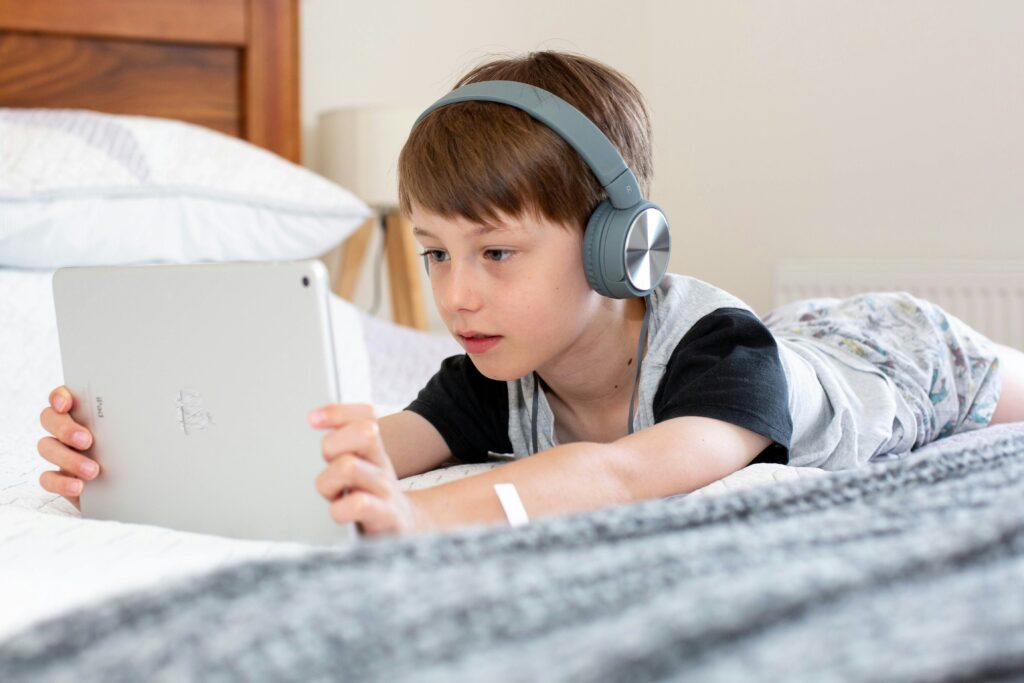
In today's digital age, the internet plays a significant role in our daily lives. While it provides a wealth of information and opportunities for learning, it also poses risks, especially for young adolescents. As modern parenting continues to evolve, it is crucial for parents to navigate conversations about internet safety and age-appropriate content with their children. In this blog post, we will explore strategies for addressing this important issue and empowering parents to guide their children in the digital landscape.
Understanding the Digital Landscape and Its Impact on Adolescents
The digital world is an ever-changing environment filled with both opportunities and challenges. Adolescents, in particular, find themselves at the intersection of curiosity. The vast expanse of the internet at their fingertips, which is not without its pitfalls. The exposure to inappropriate content can range from mildly offensive to deeply disturbing. It can potentially affect their psychological development and shape their understanding of complex issues. This can happen before they are emotionally mature enough to process them. This landscape is not static. New apps, games, and social platforms emerge, often designed to capture and hold the attention of young users for as long as possible. This can lead to an excessive amount of time spent online, further increasing the risk of encountering harmful content.
Understanding this dynamic is vital for parents who aim to protect their children from these dangers. It's not just about the content but also about understanding how and why certain content appeals to adolescents. This comprehension allows parents to have more meaningful conversations with their children about their digital habits, the content they consume, and the potential impact on their well-being. In navigating this complex digital terrain, the goal is to equip young adolescents with the critical thinking skills needed to discern and make wise choices amidst a sea of endless digital possibilities.
Recognizing the Signs Your Child May Have Been Exposed to Inappropriate Content

Being aware of behavioral changes in your child can be a key indicator that they may have stumbled upon inappropriate content on the internet. These signs can manifest in various ways, such as an increased level of secrecy surrounding their online activities. For instance, they might quickly switch tabs or hide their screens when you approach. This can indicate they are viewing something they don't want you to see. Additionally, a sudden shift in mood or behavior could be a response to disturbing content they've encountered. An example might be them becoming more withdrawn or displaying unusual aggression or anxiety.
Another red flag could be an unexplained reluctance to participate in previously enjoyed activities. It may suggest their focus or interests have been negatively influenced by their online experiences. Observing these changes requires a nuanced approach, avoiding direct accusations which may close off communication lines. Instead, these observations should serve as a cue for parents to gently probe their child's online habits and feelings about their digital interactions. This method allows parents to gather insights into their child’s online world without causing them to retreat further into secrecy. Recognizing these signs is the first step in addressing potential exposure to harmful content and reinforcing a safe online environment for your child.
Initiating the Conversation: Tips for Modern Parents
Broaching the subject of internet safety and appropriate online content with your children doesn't have to be overwhelming. The key is to approach the conversation with empathy and understanding. Don't forget to recognize that the digital world is a big part of their lives. Begin by finding a comfortable setting that feels non-confrontational, perhaps during a casual family dinner or a car ride, which can make the discussion feel more natural and less like an interrogation. It's important to communicate your concerns without instilling fear or shame. Frame the discussion around their safety and well-being. Emphasize that your goal is to ensure they enjoy the internet's vast resources responsibly.
Encourage them to share their online experiences and any uncomfortable situations they might have encountered. This approach helps to normalize discussing internet usage openly. It reinforces that they can always turn to you for guidance without fear of retribution or harsh judgment. Use this opportunity to set mutual expectations about internet use. This should include discussing what types of content are not suitable and why. Highlight the importance of critical thinking and being cautious about the information they share or receive online. Make sure they understand that you're not trying to invade their privacy or limit their exploration but are interested in their safety and development. This conversation should be an ongoing dialogue, adapting as they grow and as the digital landscape changes.
Establishing Clear Internet Usage Guidelines

To maintain a balance between the benefits and potential risks of internet use, it is imperative for parents to implement and clearly communicate internet usage guidelines. Crafting rules about when and how long the internet can be used, as well as what types of content are off-limits, lays a foundation for healthy digital habits. This involves a collaborative effort where children have a say in setting these guidelines, making them more likely to adhere to the rules.
Additionally, explaining the rationale behind restrictions helps children understand the importance of these guidelines beyond mere rules. It fosters a sense of responsibility towards their online behavior.
It's also beneficial to designate tech-free zones or times within the home. This will encourage offline activities and interactions, promoting a well-rounded lifestyle. Regularly review these guidelines together, making adjustments as your child grows and as new challenges arise in the digital world. Through clear, consistent, and collaborative guidelines, parents can create a safer online experience that respects their child's independence while safeguarding them from potential digital dangers.
Educating Your Child About Internet Safety and Age-Appropriate Content
Empowering your child with the knowledge to navigate the internet safely is a crucial aspect of modern parenting. Begin by discussing the various types of content they may encounter online. Highlight the importance of discernment in what they view, share, and engage with. Explain the concept of digital footprints and the long-term implications of their online actions. Use real-world examples to illustrate how easily personal information can be shared and exploited if not careful. Encourage them to think critically about the sources of the information they find and to question the credibility of online content.
Introduce them to the idea of digital wellness, emphasizing the balance between online activities and real-life interactions. Provide them with strategies to deal with uncomfortable situations online, such as encountering inappropriate content or being approached by strangers. This should include knowing when and how to report such instances. It also includes the importance of discussing them with a trusted adult. By fostering an environment of learning and curiosity around internet safety, you help your child develop a healthy relationship with digital technology. This can ensure they become responsible and informed digital citizens.
Utilizing Parental Controls and Safe Browsing Tools

Leveraging parental controls and safe browsing tools offers an additional layer of protection for children navigating the internet. These tools provide a means to filter out harmful content, limit screen time, and monitor online behavior. It is done without infringing on a child’s sense of independence. Educating yourself on the various options available is key. There are browser settings that restrict access to adult content to apps that track the amount of time spent on social media platforms. Engaging with your child about why these tools are being implemented helps demystify their purpose. It presents them not as measures of control but as safeguards for their digital journey.
It’s also important to regularly update these tools to keep up with new threats and to adjust settings as your child grows older and their online needs change. Involve your child in this process to foster a sense of responsibility and awareness about their digital footprint. These proactive steps not only enhance your child's online safety but also teach them about the value of boundaries in the digital realm, setting the stage for responsible internet use as they mature.
Building Trust and Fostering Open Communication

Building trust and fostering open communication with your child is foundational in navigating the digital age together. This relationship is strengthened not by fear, but through honest and empathetic dialogue about their online experiences. Encourage your child to share both their positive and negative encounters on the internet. Make sure they feel heard and supported rather than judged. Highlight that mistakes are part of learning, ensuring they understand they can come to you with any issue without fear of punishment.
Active listening plays a crucial role. When your child speaks, give them your full attention, acknowledging their feelings and offering guidance when sought. Discuss your own experiences and challenges with technology. Show them that navigating the digital world is a continuous learning process for everyone. Regularly engage in conversations about their digital interests, and together, explore new and safe online spaces that align with their passions. This ongoing dialogue reinforces that you are a reliable ally in their digital exploration, cementing a bond of trust that encourages open communication about their online life.
In todays society I feel many people, especially the younger generations are just completely absorbed in technology. They stare mindlessly into their smart phones, I-pad, laptop etc. and unfortunately miss the beauty that surrounds them. It can be a very humbling and awe inspiring experience when you realize the vastness of nature that surrounds you; even in midst of heavily trafficked suburban areas or on your drive to work, nature is pervasive.
Making Nature Fun
Walking through your local parks, forests, etc. with your children and really looking around and enjoying the present moment yields a much different experience than that of what many experience in todays modern society. It promotes mindfulness, connectedness, togetherness and an appreciation for our earth. Getting your child away from the screens and bringing them through the trails of one of your local parks can be a great way to facilitate that connectivity between your surroundings and your family. To take it a step further, learning about the local plant life and the role it plays in your environment will not only deepen the bond that you and your child form with nature and your local habitat, but can also be a deeply satisfying and rewarding experience; soon enough your child may even be teaching you a few things. If just getting your little one away from paw patrol or bubble guppies and out into nature is enough of a task right now, that is perfectly fine. Maybe once out into the woods you create your own show (Pine Cone Patrol) that can only be experienced out in the wild (you would have to come up with the characters, character development, plot, illustrations, lighting, etc.; I can’t do everything).
Research on Benefits of Being in Nature
If the prospect of leaving the warm comfy couch cushions that have molded to the shapes of you and your little ones bodies is still too uncomfortable of a thought, listen up because there has actually been some very interesting research on the benefits of immersing oneself in nature and how it may benefit your overall health (I don’t think watching a few episodes of man vs. wild will have the same therapeutic effect).One such study conducted by Repke, Berry, Conway, Metcalf, Hensen and Phelan (2018) found that study participants who scored high on items determining their accessibility to nature (accessibility to nature measured as prevalence of parks or other pleasant natural features nearby, amount of time spent outdoors and how safe one feels being outdoors in the area they live) found that those that scored high on the accessibility to nature measure also showed statistically significant higher scores on mental health measures. Another interesting finding in this study is that those participants who had increased accessibility to nature also showed lower scores on a task that measured impulsivity in decision-making. More interesting yet, participants place of residence was also examined to assess their proximity to nature (natural land cover) in their area. Interestingly enough, it was found that geospatial proximity of the participants to nature had no significant effect on health measures or reducing impulsive decision-making.
These findings are interesting in that they may suggest that there is not so much a link between your proximity to nature and mental/physical health, but rather your relationship with the nature in your surrounding area is what positively impacts your health. Let’s be honest, we could all use some decreases in impulsivity and definitely decreases in stress! Knowing that simply exposing yourself to nature (No, not in that way!) can potentially provide these benefits for you and your child (did I mention it’s free…), why would you not take advantage of this? Go out there and hug a tree; connect with your children, your environment and become healthier in the process.
Stay Shining,
Reference:
Repke MA, Berry MS, Conway LG, III, Metcalf A, Hensen RM, Phelan C (2018) How does nature exposure make people healthier?: Evidence for the role of impulsivity and expanded space perception. PLoS ONE 13(8): e0202246. https:// doi.org/10.1371/journal.pone.0202246